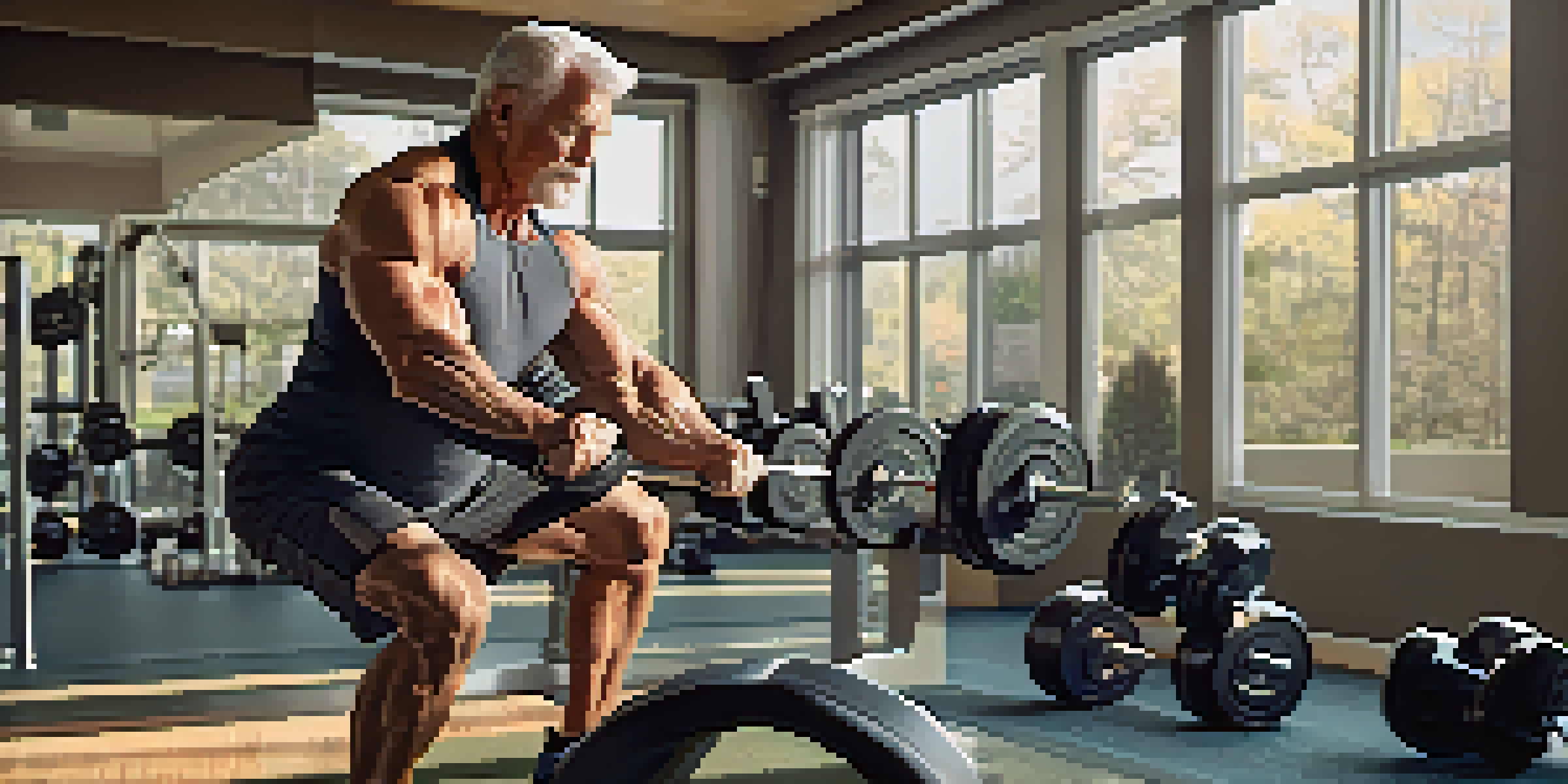Cardio vs. Strength Training: Aging Bodybuilders' Dilemma

Understanding the Aging Bodybuilder's Unique Needs
As we age, our bodies undergo various changes that can impact our fitness routines. For bodybuilders, this means reassessing how we approach exercise, especially when it comes to cardio and strength training. The goal is to maintain muscle mass while also supporting cardiovascular health, which can sometimes feel like a balancing act.
Strength does not come from physical capacity. It comes from an indomitable will.
Muscle loss, or sarcopenia, becomes a significant concern as we age, making strength training crucial. However, cardiovascular health is equally important, as it helps with endurance and overall well-being. Thus, the dilemma arises: How do you prioritize both without compromising your fitness goals?
Understanding your body's unique needs at different life stages is key. Listening to your body and adjusting your training accordingly can lead to better results and a more enjoyable fitness journey.
The Benefits of Strength Training for Older Adults
Strength training offers numerous benefits for aging bodybuilders, from increased muscle mass to improved bone density. Lifting weights not only helps to counteract muscle loss but also enhances strength, which is essential for daily activities. This is particularly important for maintaining independence as we age.

Additionally, strength training can help boost metabolism, making it easier to manage weight. This is a crucial aspect since metabolism tends to slow down with age. By incorporating regular strength workouts, older adults can optimize their energy expenditure and maintain a healthy weight.
Importance of Strength Training
Strength training is crucial for aging bodybuilders to combat muscle loss and enhance overall health.
Moreover, strength training has been shown to improve mental health, reducing symptoms of anxiety and depression. The sense of accomplishment that comes from lifting heavier weights can significantly enhance self-esteem and overall quality of life.
The Role of Cardio in Aging Fitness Routines
Cardiovascular exercise is essential for heart health, especially as we age. Engaging in regular cardio workouts can significantly lower the risk of heart disease, high blood pressure, and other chronic conditions that become more prevalent with age. This makes it a vital component of any fitness regimen for aging bodybuilders.
Aging is not lost youth but a new stage of opportunity and strength.
Beyond heart health, cardio can also aid in weight management and improve endurance. This is particularly beneficial for bodybuilders who want to perform well in their lifts or engage in other physical activities. Plus, incorporating cardio can enhance recovery after strength training sessions.
There are many forms of cardio to choose from, such as walking, cycling, or swimming, allowing for flexibility in workouts. Finding a type of cardio that you enjoy can help you stick to your routine and reap the long-term benefits of cardiovascular exercise.
Finding the Right Balance Between Cardio and Strength
Striking the right balance between cardio and strength training can be challenging but is crucial for aging bodybuilders. A well-rounded approach often includes a mix of both types of workouts, allowing for optimal health and fitness. The key is to listen to your body and adjust your routine based on how you feel.
A general guideline is to incorporate strength training at least two to three times a week, focusing on different muscle groups. On the other hand, cardio can be done three to five days a week, depending on your fitness level and goals. This variety can help keep workouts fresh and engaging.
Balance Cardio and Strength Workouts
A well-rounded fitness routine for older adults should incorporate both cardio and strength training to support heart health and muscle maintenance.
Ultimately, the best balance will depend on individual goals, preferences, and overall health. Experimenting with different routines and monitoring your body’s response can help you find what works best for you.
Common Myths About Cardio and Strength Training
Many myths surround the relationship between cardio and strength training, particularly for older adults. One common misconception is that strength training will make you bulky, which can deter individuals from lifting weights. In reality, strength training is essential for maintaining muscle mass without excessive bulk, especially when combined with a balanced diet.
Another myth is that cardio should be prioritized over strength training as we age. While cardio is important for heart health, neglecting strength training can lead to muscle loss and functional decline. It’s vital to recognize that both forms of exercise have unique benefits and should complement each other.
Lastly, some believe that older adults should avoid high-intensity workouts. While it's important to approach exercise with caution, many older individuals can safely incorporate high-intensity interval training (HIIT) into their routines. The key is to consult with a healthcare provider or fitness professional to ensure exercises are safe and appropriate.
Listening to Your Body: Signs You Need to Adjust Your Routine
As you age, it becomes increasingly important to listen to your body and recognize when it’s time to adjust your fitness routine. Signs such as persistent fatigue, joint pain, or a decrease in performance can indicate that your body needs a break or a change in training focus. Ignoring these signals can lead to injuries and setbacks.
Additionally, if you find that your motivation is waning, it might be time to tweak your workouts. Sometimes, simply changing the type of cardio or incorporating new strength exercises can reignite your passion for fitness. Variety can be a game changer in keeping your routine enjoyable.
Listen to Your Body's Signals
Recognizing signs of fatigue or pain and adjusting your workout routine accordingly is essential for preventing injuries and promoting longevity in fitness.
Finally, consider your recovery times. As we age, our bodies may require more time to recover from intense workouts. If you notice prolonged soreness or fatigue, it may be beneficial to incorporate more rest days or lighter workouts into your routine.
Creating a Sustainable Fitness Plan for Longevity
When it comes to fitness, sustainability is key, especially for aging bodybuilders. Creating a balanced routine that incorporates both cardio and strength training can lead to long-term success and health. Consider setting realistic goals that focus on progress rather than perfection, allowing yourself to celebrate small victories along the way.
Incorporating flexibility and mobility exercises is also vital for maintaining overall health. These workouts can enhance joint function and reduce the risk of injury, ensuring that you can continue your fitness journey for years to come. Activities like yoga or stretching can play a significant role in your routine.

Lastly, remember that consistency is more important than intensity. Finding a workout schedule that fits seamlessly into your life will help you stay committed. Over time, the cumulative effects of regular exercise will lead to improved strength, endurance, and overall well-being.